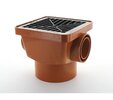There is a concrete slab just outside my back door which I absolutely despise. It always seems to be filthly with a green tinge (i'm assuming because of standing water).
I dont know if I have the energy to pull it up and re-lay it as I wont be in this house for more than another year or two, but I did wonder if it might be possible to polish the floor?
I don't need a mirror finish, but I just want something that feels a little more considered and is easier to clean!
Has anyone tried polishing an exterior concrete slab before? Any tips / advice / thoughts?
The slab is slightly sloped and certainly isn't even, so I don't want to go to the expense of renting a grinder if it's not going to be possible

I dont know if I have the energy to pull it up and re-lay it as I wont be in this house for more than another year or two, but I did wonder if it might be possible to polish the floor?
I don't need a mirror finish, but I just want something that feels a little more considered and is easier to clean!
Has anyone tried polishing an exterior concrete slab before? Any tips / advice / thoughts?
The slab is slightly sloped and certainly isn't even, so I don't want to go to the expense of renting a grinder if it's not going to be possible



